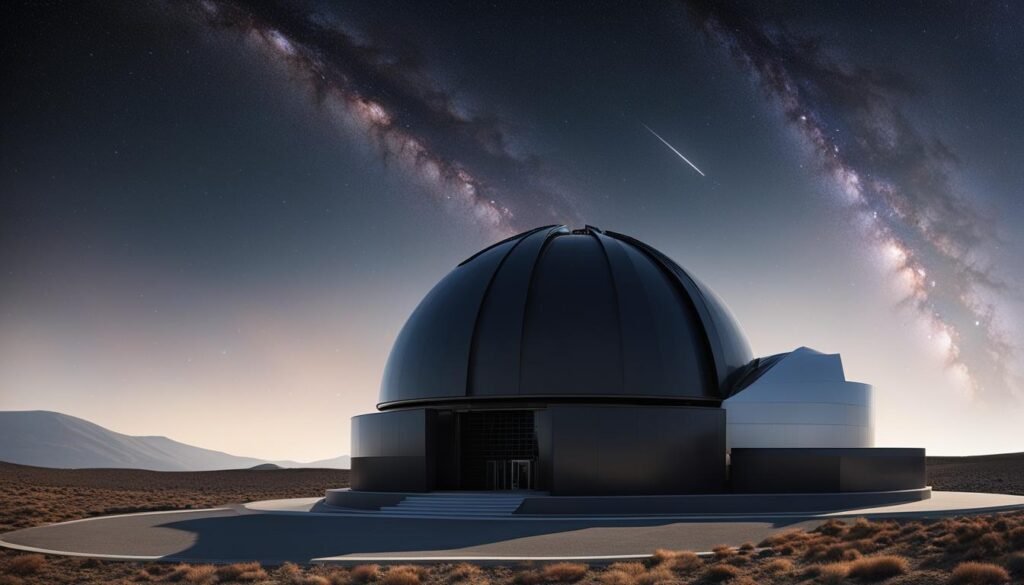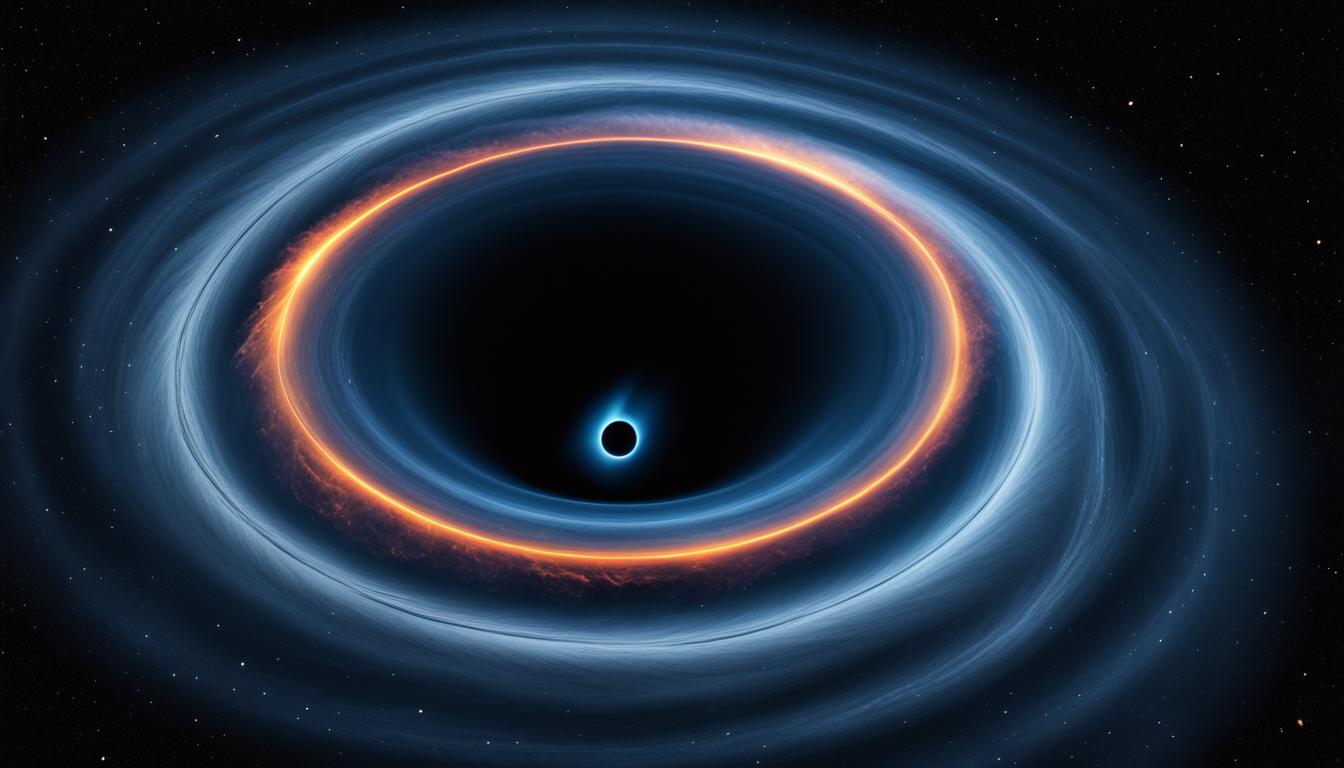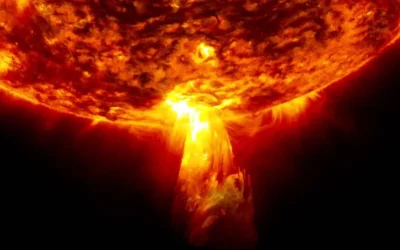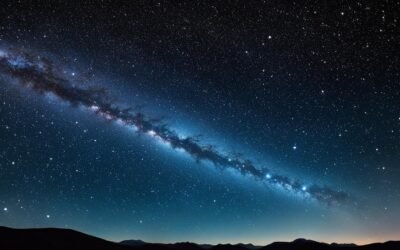Imagine witnessing a cornerstone of physics and cosmic wonder, as if gazing upon a starry sea and for the first time discerning the outline of a Leviathan beneath the waves. You’ve encountered a similar groundbreaking moment with the release of the first image of a black hole captured in M87, a mesmerizing gateway to the inconceivable depths of space and time. This history-defining black hole image M87 does not merely represent a photograph; it acts as a beacon reaffirming the existence of these enigmatic spectacles and introduces you to the previously unseen silhouette of gravity’s ultimate wellspring. Encased in a bright photonic ring, the M87 black hole photo by the Event Horizon Telescope (EHT) Collaboration is a testament to our odyssey into the cosmic unknown, challenging and expanding the frontier of human knowledge.
Key Takeaways
- The first-ever photograph of a black hole provides concrete visual evidence of its existence.
- M87’s black hole image is crucial for confirming theories about the universe.
- Global collaboration was key to the successful capture of this cosmic phenomenon.
- The image supports Einstein’s Theory of General Relativity with observable data.
- This achievement opens a new chapter in understanding the cosmos and our place within it.
The Groundbreaking M87 Black Hole Image Release
As you explore the cosmos through the lens of the Event Horizon Telescope (EHT), you witness a historic moment in astronomy – the m87 black hole image release. This monumental event marks the first time humanity has captured an image of a black hole, specifically, the gargantuan one located in the heart of the m87 galaxy. We are not just talking about any ordinary celestial snapshot; this history making black hole photo m87 is a visual proof of an object whose existence was once only theoretical.
The sheer magnitude of the m87 galaxy’s black hole captivates the scientific community and onlookers alike; it is a beast with a mass over 6.5 billion times that of our sun. The photograph reveals the black hole’s silhouette, a stark contrast against an orbiting bright ring of light – a direct consequence of the gravitational bending of light around the black hole’s event horizon. This phenomenon transforms a part of the cosmos previously hidden from our eyes into a stunning visual that will be studied for years to come.
The unveiling of this image marks a pivotal shift in our understanding of the universe. By seeing the unseeable, we confirm that black holes are not just figments of our mathematical imaginations but rather concrete parts of our physical reality. – EHT Collaboration Spokesperson
The m87 galaxy black hole capture serves as a beacon for scientific discovery, reaffirming theoretical predictions with tangible evidence. It charts an incontrovertible point in space and time where matter and light cannot escape, allowing us to peer as close to the edge of infinity as currently possible.
Engaging with this groundbreaking image, you are not merely a bystander but part of a collective human experience, sharing in the wonder and revelations that such breakthroughs bring. Not only does this open a new window into observing the dynamics of space, but it also anchors a newfound appreciation for the profound puzzles that the cosmos still holds. As we look ahead, the horizons of astrophysical research expand, promising even more breathtaking revelations within the enigmatic depths of our universe.
The Role of the Event Horizon Telescope (EHT) Collaboration
The Event Horizon Telescope (EHT) Collaboration has redefined what it means to study the cosmos. Through their extraordinary efforts, they have brought to light the shape of the invisible, galvanizing the world of astrophysics and captivating imaginations worldwide with the m87 black hole discovery. It is their groundbreaking work that provided us with the m87 black hole photograph, an image that will undoubtedly be etched in the annals of scientific history.
Linking Radio Observatories Across the Globe
Imagine the sheer scale of syncing eight radio observatories spread over the planet. That’s exactly what the EHT Collaboration did, creating a single, Earth-sized aperture capable of peering 55 million light-years away into the heart of the Messier 87 galaxy. Each telescope, from the frigid South Pole to the lofty Chilean peaks, became a pixel in the eye of a larger sensor, capturing a piece of the puzzle that, when assembled, gave us an unprecedented view of a black hole’s event horizon.
History-Making EHT Network Observations
Never before had humanity collected over a petabyte of astronomical data with such precision. The synchrony was so exact that the difference in time between the telescopes’ data capture was less than the time it takes for light to travel between them. This unity was crucial in filtering the cosmic noise and isolating the silhouette of the M87 black hole for all to see.
| Observatory | Location | Contribution |
|---|---|---|
| ALMA | Chile | High-altitude precision data |
| APEX | Chile | Complementary radio waves |
| IRAM 30m | Spain | Northern hemisphere data |
| James Clerk Maxwell Telescope | Hawaii, USA | Tropical climate data |
| Large Millimeter Telescope | Mexico | Key imaging contributions |
| Submillimeter Array | Hawaii, USA | High-frequency detail |
| Submillimeter Telescope | Arizona, USA | Additional resolution |
| South Pole Telescope | Antarctica | Polar perspective |
This remarkable venture, a testament to human cooperation and curiosity, has not only bolstered our understanding of the universe but also strengthened the global science community. The Event Horizon Telescope (EHT) Collaboration is an exemplary model of how boundaries are surpassed and the seemingly impossible is achieved through unity in pursuit of a common goal.
About the Supermassive Black Hole in M87 Galaxy
The core of the Messier 87 galaxy harbors a colossal titan of the cosmos, known as M87*. This supermassive black hole is not only a spectacle of immense mass but also a natural laboratory for observing the extremes of physics. Positioned at a staggering 53.49 million light-years away, it presents an incredible subject for scientists and astronomers in their quest to understand the universe.
The Scale and Power of M87*
With a mass equivalent to 6.5 billion of our suns, the M87* black hole looms large as one of the most powerful forces known to mankind. Unlike anything within our planetary experience, it features an enormous gravitational pull that orchestrates a symphony of cosmos phenomena around it. Here, glowing gas spirals into what seems like an abyss, emitting jets of particles at nearly the speed of light and sketching out the silhouette of this cosmic giant.
Glowing Gas and Bending Light
The iconic M87 galaxy black hole image captured by the Event Horizon Telescope illuminates what was once considered unseeable. A circular shadow enveloped by a luminous accretion disk reveals the intricate dance of glowing gas as it succumbs to the relentless gravity of the black hole. This gas heats up and emits bright light that traces the curvature of spacetime, demonstrating light-bending gravity in action—a mesmerizing show put on by the universe itself and a stunning affirmation of the predictive powers of physics.
Indeed, your gaze upon the M87 black hole image brings you face-to-face with a black hole silhouette, a milestone in human achievement that represents the persistent curiosity driving scientific exploration. Thanks to this landmark discovery, you now possess a clearer visualization of these astronomical wonders, unveiling aspects of the universe that continue to challenge and expand our understanding.
How Scientists Captured the First Image of a Black Hole Captured in M87
The monumental task of capturing the first-ever black hole picture M87 was not something achieved by a single telescope or instrument. Instead, it required a global effort that harnessed the power of interferometry, an astronomical method where waves, especially electromagnetic waves, are superimposed to extract information that is not available from individual sources alone. Below, discover the meticulous steps and challenges overcome by the Event Horizon Telescope (EHT) collaboration in capturing the black hole image.

In simple terms, interferometry involved coordinating multiple radio telescopes around the world to focus on the supermassive black hole residing in the center of the M87 galaxy. This network of telescopes operated synchronously, collecting data simultaneously to mimic a giant telescope roughly the size of our planet. The EHT collaboration faced the daunting task of collecting and combining these disparate data sets—a process comparable to piecing together a cosmic jigsaw puzzle.
- Radio telescopes across the globe, from Hawaii to Spain and from Antarctica to Chile, were precisely aligned to observe M87*.
- The telescopes gathered petabytes of data, each functioning as a component of a single colossal virtual telescope utilizing Earth’s diameter to achieve the necessary resolution.
- The unconventional approach allowed the team to observe details as fine as an orange on the surface of the Moon, evidencing the lengths to which scientists went to document this scientific marvel.
Without interferometry, the phenomenal details of the M87 black hole’s event horizon would remain invisible to us. This technique allowed for an unprecedented resolution, bringing into focus the shadow of the black hole against the accretion disk’s glowing light—an accomplishment symbolizing one of humanity’s most profound sightings into the cosmic depths.
Einstein’s Theory of General Relativity and Black Holes
The revelation of a black hole’s ring size within the M87 galaxy lends empirical support to Einstein’s Theory of General Relativity. As Einstein surmised, the fabric of space-time is curved by mass and energy, dictating the motion of objects and even light itself. These intrinsic predictions by Einstein have stood against the observational evidence presented by the Event Horizon Telescope (EHT), marking a remarkable confirmation of gravity’s behavior surrounding these celestial behemoths.
Predicted vs. Observed Phenomena
When Einstein formulated his theory over a century ago, black holes themselves were mere conceptual entities. Yet, the predictive power of his equations extended far enough to describe their mysterious peripheries accurately. The observed ring size encircling the M87 black hole matches remarkably well with theoretical predictions, providing a compelling visual endorsement of general relativity in one of the universe’s most extreme environments.
Expanding Our Understanding of Gravity
It’s not just the affirmation of general relativity that captivates scientists; it’s the nuanced understanding of gravity’s behavior under the black hole’s gravity influence that excites physicists today. By measuring the precise mass of the black hole in M87 and observing the light as it bends around its gravity, we are ushered into a new era where our mathematical models of gravity can be examined and refined to greater precision.
| Aspect | General Relativity Prediction | M87 Black Hole Observation | Implication for Physics |
|---|---|---|---|
| Gravity’s Influence on Light | Light will bend around massive objects | Visible bending around black hole | Confirms gravitational lensing |
| Mass-Energy Influence on Space-Time | Heavy objects curve space-time | Mass of black hole significantly curves surrounding space | Supports the theory’s core principle |
| Event Horizon Ring Size | Dependent on mass and gravity’s pull | Matches predicted size and appearance | Validates Einstein’s equations for black holes |
| Gravitational Pull on Accretion Disk | Should alter disk’s emission | Measurements consistent with strong gravitational pull | Allows for refined models of accretion physics |
As we continue to probe the enigmatic nature of black holes, your understanding of the universe is further enriched by Einstein’s enduring legacy and the relentless pursuit of knowledge by today’s astrophysicists. Einstein’s timeless principles, once confined to chalkboard scribbles, now animate the very essence of the cosmos, continuing to challenge and inspire our curiosity.
Analyzing and Interpreting Black Hole Data
When faced with the enigmatic wonders of the cosmos, especially black holes, scientists are continuously innovating ways to interpret the universe’s cryptic signals. One of the formidable challenges includes analyzing black hole data, a task that pushes the boundaries of current astrophysical techniques and demands sophisticated tools for black hole imaging.
The Challenge of Rapid Gas Movement
The swirling maelstrom of gas movement around black holes poses a substantial hurdle. In the M87 galaxy, gas encircles the black hole at such high velocities that it completes an orbit in a matter of minutes. This rapid movement necessitates real-time data analysis, imposing stringent requirements on the precision and speed of observing instruments.
Developing Sophisticated Tools for Data Analysis
To keep pace with the extraordinary dynamism of black holes, the Event Horizon Telescope (EHT) team pioneered the development of advanced analytical tools. These tools are vital for effectively interpreting black hole evidence, allowing us to draw accurate conclusions from the plethora of data harvested by the EHT’s global network.
The analytical juggernaut comprised of complex algorithms took form through collaboration, innovation, and relentless testing. With the use of cutting-edge supercomputers, the data could be meticulously sifted to unearth patterns aligned with the theoretical models of black hole behavior.
The following table provides a glance at the critical aspects of these sophisticated tools compared to traditional methods:
| Aspect | Traditional Methods | Sophisticated EHT Tools |
|---|---|---|
| Real-time Capability | Limited by data processing speed | Enhanced for immediate analysis |
| Accuracy of Imaging | Constrained by instrument sensitivity | High-resolution capture of dynamic events |
| Computational Power | Insufficient for simulating complex models | Robust performance for rendering detailed simulations |
| Data Volume Management | Challenging with large data sets | Optimized algorithms for vast data sets |
| Pattern Recognition | Generalized and less precise | Customized for identifying black hole-specific patterns |
As you delve into the intricacies of these tools, it becomes evident how crucial they are to the endeavor of interpreting black hole evidence. The journey from chaos to clarity in black hole research is underpinned by the continuous refinement of these sophisticated instruments, and with each advancement, we step closer to unlocking the universe’s deepest secrets.
The Collaboration: Over 300 Researchers from 80 Institutes
The unveiling of the M87 black hole image stands as a testament to the power of the EHT collaboration, a multinational research effort comprised of over 300 dedicated scientists and engineers spanning 80 institutions worldwide. Your understanding of the cosmos has been significantly enhanced by this remarkable blend of intellect and technology, pooling a diverse array of knowledge and expertise to achieve what was once deemed impossible.
This monumental project showcases the pinnacle of human cooperation. The EHT consortium represents a myriad of countries, blurring the lines of nationality and proving that unified pursuits in science can lead to groundbreaking discoveries. Researchers within the EHT collaboration hail from institutes that include titans of academia, government-funded observatories, and private-sector research facilities, each contributing unique skills and resources to the initiative.
To gain further insight into the global scope of this project, consider the following table that highlights a selection of participating countries and institutions within the EHT collaboration:
| Country | Associated Institutes |
|---|---|
| United States | Harvard-Smithsonian Center for Astrophysics, MIT Haystack Observatory |
| Germany | Max Planck Institute for Radio Astronomy |
| Chile | ALMA Observatory |
| Spain | Instituto de Astrofísica de Andalucía |
| Japan | National Astronomical Observatory of Japan |
| Taiwan | Academia Sinica Institute of Astronomy and Astrophysics |
| France | Paris Observatory |
| South Africa | Square Kilometre Array South Africa |
Each researcher, each institute has contributed to the mosaic of knowledge and technology that enabled us to glimpse directly into the abyss of a supermassive black hole. Through their concerted efforts, the EHT collaboration not only captured an image but also cemented the essential role of international cooperation in pushing the boundaries of human discovery.
Advancements and Future Endeavors in Black Hole Imaging
The relentless pursuit of cosmic discovery continues to drive the Event Horizon Telescope expansion, propelling us further into the realm of celestial wonders. With the historic snapshot of the black hole in M87 serving as just the beginning, we now stand on the cusp of a new age in astronomy—a thrilling prospect that will offer future black hole observations with unparalleled clarity and depth.
Ongoing Expansion of the EHT Network
Your understanding of the cosmos is about to be significantly broadened thanks to the strategic growth and technological advancement of the EHT network. As it encompasses more sophisticated instruments and telescopes across the globe, including the Greenland Telescope (GLT), your grasp of these mysterious voids will deepen in ways previously imagined only in the realm of science fiction. This expansion not only promises a revolution in next-generation black hole imaging, but also a broader platform for discovery that challenges our current perceptions of space and time.
Potential for More Detailed Images and Movies
Imagine the power of viewing detailed black hole movies, witnessing the dynamic environment around these enigmatic entities as they pull in and churn the very fabric of existence. This is no longer mere speculation. With the ongoing advancements in the EHT’s capabilities, scientists anticipate a time where real motion pictures of black holes will become a reality. These detailed visual narratives will offer you, and the wider scientific community, a profound look at the processes shaping our universe.

As our technological prowess grows in leaps and bounds, so too does our potential to slice through cosmic mysteries that have baffled humanity for generations. The treasures hidden within these shadows of the cosmos are growing ever more accessible, ready to divulge their secrets through the lens of the EHT and your unwavering curiosity.
Impacts on Science Education and Public Interest
The Event Horizon Telescope’s groundbreaking capture of a black hole image has had a significant black hole research impact, rippling outwards to influence both science education and fuel the public interest in astronomy. Educators and institutions are now capitalizing on this surge in curiosity by integrating contemporary astrophysical discoveries into their curriculums, cultivating a well-informed and inspired populace. The insightful imagery allows for abstract concepts to become tangible, enabling educators to discuss the once elusive astronomical phenomena with newfound clarity.
Your engagement with astronomy need not be confined to academia – as public interest peaks, community events, local observatories, and digital platforms offer you the opportunity to witness science in motion. These developments in black hole research have essentially provided a window to the cosmos, encouraging people of all ages and backgrounds to look up at the stars with wonder, a sense of kinship, and a thirst for knowledge about what lies beyond.
This fervor for understanding fosters a global conversation which underscores the importance of science education, highlighting its potential to unite us in our pursuit for answers. As a testament to this unity, consider how online forums and social media channels have buzzed with discussions, theories, and aspirations concerning black hole research impact and its implications for future deep space explorations.
The profound implications of the M87 black hole image underscore the intrinsic relationship between scientific advancements and educational growth.
Moreover, as a participant in this era of expansive public interest in astronomy, you have an unprecedented opportunity to witness science history in the making—a venture that ignites the imagination and reveals the interconnectedness of the universe. Thus, we see that the reverberations of a single image can indeed challenge and expand the horizons of human understanding.
Continued Exploration: Tracking Black Hole Behavior
The journey into deep space continues, with astrophysicists relentlessly pursuing the enigmatic dance of black holes. The historic imaging of the supermassive black hole in the M87 galaxy represents more than a singular achievement; it heralds a new chapter in black hole behavior exploration. This is where the fabric of our cosmic understanding is stretched to new limits, allowing us to observe the gravitational choreography that shapes both the visible and invisible universe.
A deeper dive into supermassive black hole studies sharpens our insight into the intricate mechanisms of the cosmos. The black hole’s gravity-well, a point of no return, is where the laws of physics are both confirmed and questioned. You are witnessing an unfolding saga of these celestial entities which influence the grand symphony of galactic formation and evolution. As observers on this spaceship Earth, your grasp on the complex narrative of these cosmic giants’ behavior improves with each study, cementing their roles as the architects of the galaxies we chart and the stories we construct about our universe.
In the era post-M87 revelation, tracking these gravitational enigmas has become a more tangible reality. Your passion for the stars, your thirst for knowledge, and the human capacity for wonder drive the quest forward, promising answers to questions yet to be formed. The continuation of this astronomical pursuit stands as a testament to humanity’s reach for the skies, where each discovery fuels the next leap toward understanding our expansive, mystifying universe.
FAQ
What does the first image of a black hole in the M87 galaxy reveal?
The first image of a black hole in the M87 galaxy reveals a black hole silhouette set against a bright emission ring, providing visual confirmation of black holes and further substantiating Einstein’s Theory of General Relativity.
How was the M87 black hole image captured?
The M87 black hole image was captured by linking radio observatories across the globe as part of the Event Horizon Telescope (EHT) Collaboration, creating a virtual Earth-sized telescope. Observatories like ALMA and APEX collected over a petabyte of data to be analyzed for this purpose.
What does the EHT Collaboration entail?
The Event Horizon Telescope Collaboration is a global network of radio observatories that work in unison to study objects such as black holes. For the M87 black hole photograph, eight observatories were connected to provide the necessary data.
Can you explain the significance of the glowing gas and light bending around the black hole?
The glowing gas around the black hole is the accretion disk, comprising material spiraling into the black hole. Light from this gas is bent due to the black hole’s extreme gravity, which illuminates the black hole’s silhouette and allows us to observe its shape.
What part did Einstein’s Theory of General Relativity play in the black hole image?
Einstein’s Theory of General Relativity predicted the existence of black holes and that their massive gravity would warp space, bending the light around them. The M87 black hole image showcases a ring of light consistent with this theory’s predictions and thus reinforces the theory itself.
How did the movement of gas around the black hole affect the image capturing process?
The rapid orbiting of gas around the black hole posed a challenge, as it changed brightness and distribution quickly. The EHT team had to develop new tools and algorithms to account for this and ensure an accurate representation in their final image.
Who is responsible for the M87 black hole discovery?
The discovery was made by the Event Horizon Telescope Collaboration, which comprises over 300 researchers from about 80 institutes worldwide, showcasing an epic feat of international cooperation.
How will the Event Horizon Telescope’s advancements help future black hole studies?
The technological advancements and expansion of the EHT network will lead to sharper images and potentially movies of black holes. This will provide deeper insights into the dynamic processes occurring in the immediate vicinity of black holes.
How has the black hole image impacted science education and public interest?
The release of the M87 black hole image has generated widespread public interest and curiosity, which has influenced science education by inspiring curricula developments and motivating future generations to pursue careers in research and astronomy.
What are the next steps in black hole exploration following this discovery?
Following this groundbreaking discovery, scientists plan to conduct more detailed observations and comparative studies of various black holes. This exploration aims to understand better the behavior and impact of black holes on galaxy formation and evolution.







